- Military Art in the Civil War
This chapter gives background information on the operational level of war and specific details applicable to the Civil War. First discussed are several theoretical styles of warfare with modern era examples. Next are illustrations of the specific organization of the Union and Confederate armies of 1864, from corps level down to companies. Succeeding sections cover types of operations (offensive, defensive, etc.), movement, intelligence, logistics, communications, and staff actions as they occurred during the Civil War.
Styles of Warfare
Recently there has been a lot of emphasis on "styles of warfare" pursued by different armies at different times. Often Civil War campaigns have been used to illustrate these styles. For instance, some current literature contrasts "attrition" with "maneuver" styles. Others compare "persisting" with "raiding" strategies, or "combat" versus "logistics" strategies.
Operational Modes
Archer Jones, in his volume entitled The Art of War in the Western World1 defined eight characteristic "strategies" (better entitled operational modes). Table 2 lists these eight operational modes.
Table 2. Operational Modes
|
offensive combat persisting |
defensive combat persisting |
|
offensive combat raiding |
defensive combat raiding |
|
offensive logistic persisting |
defensive logistic persisting |
|
offensive logistic raiding |
defensive logistic raiding |
The terms used are three sets of contrasting pairs of words: offensive, defensive; combat, logistic; and persisting, raiding. Offensive refers to taking the initiative against the enemy, usually by some movement against his positions. The defensive is in some sense the opposite, awaiting the enemy�s initiative. A combat operational mode seeks a decision by directly engaging and trying to defeat or destroy the combat forces of the enemy, while a logistics mode avoids contact with the main force of the enemy, attacking supplies, civilians, or other "soft" targets. A persisting mode seeks to occupy specific areas, while a raiding mode concentrates on destroying specific objectives (combat or logistic), but not retaining possession. In real warfare, an operational commander will mix and vary his modes depending on the situation.
Modern Example
The war in Vietnam illustrated many of these operational modes. The United States military employed an offensive combat raiding mode against the North Vietnamese in remote areas, the U.S. and South Vietnamese employed a defensive persisting mode (both combat and logistic) in populated areas, and the air forces employed an offensive logistic raiding mode against supply lines. The North Vietnamese and the Viet Cong employed an offensive combat raiding mode until Tet 68, when they switched to an offensive combat persisting mode. Although they were tactically defeated (and the Viet Cong virtually destroyed during Tet), the long-term effect of the intense fighting was to take the U.S. out of the war because of Tet's effect on civilian morale. The North Vietnamese's initial renewal (after rebuilding forces) of the offensive combat persisting mode in 1972 was also defeated, but their final renewal of this mode in 1975 was successful because the earlier operations had caused the United States to withdraw.
Early in the American Civil War, both sides used the combat persisting mode (the Confederacy on the defensive and the Union on the offensive), but the Union soon adopted a logistic persisting strategy with a coastal blockade and occupation of the Mississippi River and the state of Tennessee. Both sides employed raiding as a secondary mode. Arguably, the collapse of the Confederacy was due to the loss of military and civilian morale caused by General Sherman's successful execution of the offensive logistic raiding mode against Georgia and the Carolinas in late 1864 and in 1865, after the end of the campaign discussed in this book.
Attrition Versus Maneuver
In contrast to this rather complex idea of operational modes, the attrition versus maneuver debate prevalent in recent years addresses only two modes, attrition warfare and maneuver warfare.
Attrition warfare is described as the direct clash of forces, without finesse, lasting until the superior force overwhelms the inferior. It is said to be the traditional U.S. Army style, characterized by firepower, practiced by General U.S. Grant in the Civil War, and exemplified by the theories of Clausewitz.
Maneuver warfare is described as the antithesis of attrition. Maneuver warfare practitioners avoid enemy�s strengths, "maneuvering" against his vulnerabilities to defeat him. It is said to be the traditional German style, characterized by mobility, practiced by General T. J. [Stonewall] Jackson in the Civil War, and exemplified by the writings of Sun Tzu.
These brief descriptions make the case for maneuver warfare almost inarguable. Unfortunately, this view is somewhat oversimplified: maneuver without threat of attrition and attrition without maneuver are nearly pointless in any military sense. The enemy is usually smart enough to meet your maneuver with one of his own, precipitating the attrition neither side desired. Nevertheless, the attrition versus maneuver debate has generated many articles and much heated discussion in military circles in recent years. [For instance, see: Richard D. Hooker, Jr., editor, Maneuver Warfare: An Anthology (Novato, California: Presidio Press, 1993) for both sides of the issue or Robert R. Leonhard, The Art of Maneuver: Maneuver-Warfare Theory and AirLand Battle (Novato, California: Presidio Press, 1991) for a maneuver advocate�s point of view.]. Debaters use campaigns and battles from the American Civil War to make their points, but most operational commanders in that war started an offensive campaign attempting to out-maneuver their enemy and ended up with a battle characterized primarily by attrition. Their opponent had anticipated the maneuver or had reacted in a timely manner, precipitating a direct confrontation. After the first year of the Civil War, both sides had evolved organizations, army corps, modeled on those of the Napoleonic Wars (fought in Europe fifty years previously) that could conduct both independent maneuvers or head-to-head fights.
Organization
In 1864, the basic independent war-fighting entity of both the Union and the Confederacy was the field army. An army, usually made up of several army corps, was expected to campaign and fight battles against its counterpart on the other side.
An army corps consisted of a force of two to four divisions, each with 3,000 to 8,000 men, for a total of 10,000 to more than 20,000 soldiers. A corps could be expected to operate a short distance away from the rest of its army but not so far that it could be cut off by the enemy. Each corps would usually have assigned to it one or more road upon which to move and deploy.
Figures 1 through 6 below show the basic organizational structures of typical Civil War armies and their modern map symbols.
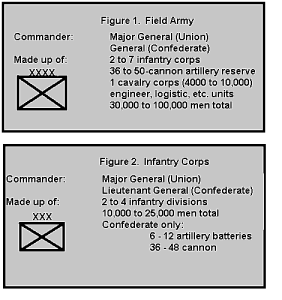
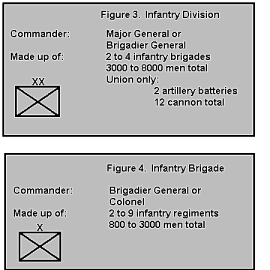
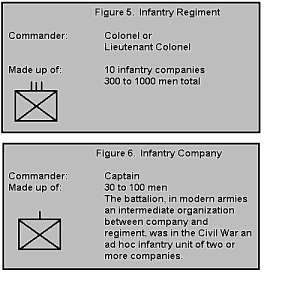
The figures show several differences between the Union and Confederate sides. Two are the ranks of the higher ranking officers�the entire Union army having only one lieutenant general, Grant, and no full generals�and the allocation of artillery, to division level in the Union army under Sherman and to corps level in Johnston's Confederate army. The focus of this book is the army group�field army�army corps level of command, so these and other, minor differences are not addressed.
Civil War armies were infantry armies. Most soldiers carried muzzle-loading, single-shot rifles (sometimes smoothbore muskets or, rarely, repeating rifles), marched on foot, and fought in ranks facing identically organized infantry lines on the other side. Of the effective soldiers present in General Sherman's command on April 30, 1864, over 80% were infantrymen. More than 6% were artillerymen, over 7% were cavalry, and the rest were engineers and headquarters staff.
In the North Georgia campaign, General Sherman controlled the entire Military Division (not to be confused with the division, a tactical unit) of the Mississippi, which included three field armies (although one was really just a corps plus cavalry) in the Chattanooga area. In modern terms, Sherman was an army group commander. He conducted operations by issuing orders to his three army commanders, coordinating their operations towards a single objective.
Operations
There are three classic types of operations: offensive, defensive, and retrograde.
Offensive operations take the
initiative, seizing territory and defeating the enemy's army.
Defensive operations defeat an attack,
gain time, retain territory, and allow forces to be concentrated elsewhere.
Retrograde operations trade space for
time, allowing the enemy to gain territory but penalizing the gain when
possible. Retrograde is often used when the enemy is so strong a defense would
be unsuccessful.
Although details of execution differ over time, the basic forms of each operation as practiced today would be recognizable to Alexander the Great.
Offensive
Offensive operations�attacks�come in six forms: envelopment, frontal attack, infiltration, penetration, raid, and turning movement. Not strictly an attack, the investment or siege of a fortified position may be considered a seventh form of offensive combat. Civil War armies used all forms, although infiltration was normally employed only as a raider's tactic. Forms of the attack are illustrated in the succeeding pictures. In each, the Blue side is attacking the Red.
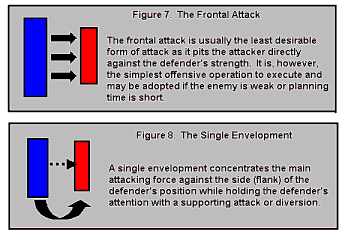
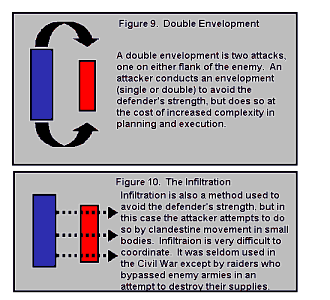
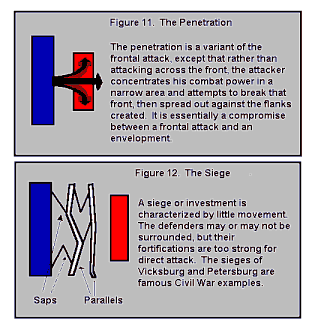
Bombardment, starvation, mining, and the building of trenches (parallels) closer and closer to the defense�to cut down on the casualties of the attackers if an assault proves unavoidable�are the hallmarks of a siege. Communications trenches�known as saps�connect the successive trench lines and provide the covered approach used to construct the next parallel. A siege is slow and costly but Civil War commanders considered its outcome�the defeat of the defender�to be almost inevitable.
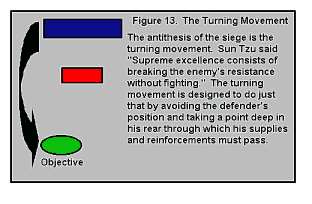
[The Sun Tzu quote is cited in endnote 2.] The turning movement should cause the defender to abandon his position, perhaps to attack the attacker or perhaps to retreat. Civil War commanders often attempted to "turn" their opponent's position.
Not illustrated is the raid, a form of attack similar to a turning movement. There is one important distinction: in a turning movement, the attacking army has adequate supplies and supply lines to sustain itself until the enemy army must act, while in a raid the attacking army�or more often a portion of the army�cannot adequately sustain itself behind enemy lines and must either quickly defeat the enemy's army or move to a place where supplies can reach it. Raiding by cavalry and by entire armies was frequent during the Civil War; a famous example was Lee's Gettysburg campaign.
A modern example of many of these offensive operations can be found in Operation Desert Storm, the liberation of Kuwait in 1991. At the conclusion of the air campaign (an offensive raiding operational mode conducted against both combat and logistics targets), General Schwarzkopf adopted an offensive combat persisting operational mode with his ground forces. His preponderance of strength allowed him to perform several offensive operations in near parallel. Figure 14 illustrates these modes against the familiar map of the Kuwait theater.
Modern Example
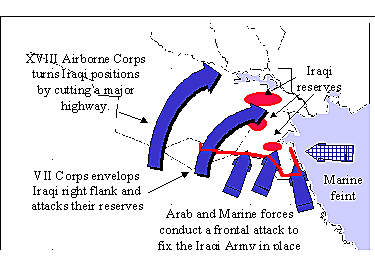
Figure 14. Allied Offensive Operations During Desert Storm
It is interesting to note that the Iraqi high command did not expect either the envelopment or the turning movement because they believed that it was impossible to move or supply large formations of troops that deep in the desert. The air campaign had blinded their sensors and deception operations (including dummy radio traffic) led them to believe all the Allied major units were still opposite their own positions.
Defensive
In contrast to the offensive, Civil War commanders used only a single form of defense. They might choose to entrench or not�in 1864 they usually did�yet the form of the defense was the same in either case. The army would be posted on high ground, if possible, with its flanks protected from envelopment by terrain barriers such as rivers, swamps, dense forest, steep hillsides, or similar obstacles. The infantry and artillery would be deployed linearly, with a strong force�a reserve�sheltered behind the line to help any unit being overwhelmed. The reserve could also counterattack the attacker if he should show a weakness. The cavalry would be deployed in advance of the front initially (to maintain contact with the enemy and to determine the location of his strength) and later on both flanks�as a screening force�to warn of an attacker's turning movement or envelopment. A well-posted defender could usually defeat a direct attack upon his position, even when the attack was conducted by superior numbers.
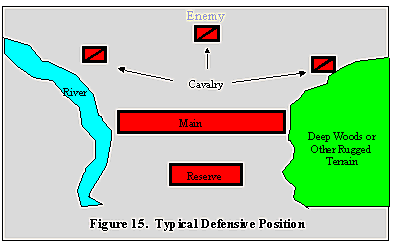
Interestingly, the Iraqis followed this pattern in 1991 (see Figure 14). They anchored their flanks, left on the Persian Gulf and right on the "impassable" desert. They kept strong reserves. However, their "cavalry" (air reconnaissance) was taken out of the battle early and their right flank proved vulnerable to both an envelopment and a turning movement. Additionally, the massive artillery and air bombardment weakened their positions and made movement of their reserves very difficult.
Retrograde
Giving up ground during the Civil War without losing soldiers, wagons, artillery, supplies, and wounded men was very difficult. Almost inevitably someone would not get the word promptly or the enemy would interfere with the operation. There are three forms of the retrograde, all of which were used during the Civil War: the delay, the withdrawal, and the retirement.
A delay is undertaken when a force, in contact with the enemy, retreats slowly, trading space for time. The idea is to give up ground grudgingly. At likely places, the delaying force will set up an ambush or a defensive position, causing the attacker to sustain casualties and making him stop and deploy for an attack. Just before the attack is delivered, the defender retreats, causing the attacker to reform his marching columns and resume his march. The toughest problems for the delaying commander are choosing the right moment to retreat and disseminating that order to all of his forces. Two delaying techniques are used: delay on successive positions and delay on alternate positions. 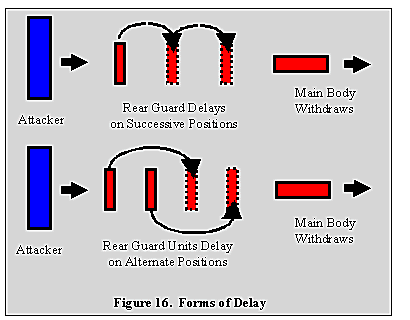
During the Civil War, delay on successive positions by a designated rear guard was preferred because of the difficulty in coordinating between units occupying alternate positions.
A withdrawal differs from a delay in that the force, in contact with the enemy, attempts to break contact with him and to retreat to a new position unmolested. Because the withdrawing force is vulnerable to a quick attack, particularly at the moment it starts moving, the withdrawing army may try to hide its move by starting at night or in bad weather, or by launching a diversionary attack to cover the movement of the main body.
A retirement is the retrograde movement of a force not in contact with the enemy. The force may be retreating from an exposed position, where it could be cut off, or it may retire from a post that the commander deems less important than another.
Although the details of execution may differ, the classic forms of the offensive, the defensive, and the retrograde are as valid today as they were 130 years ago. A complete discussion of these operations in their modern context�with examples from the Civil War�may be found in the U. S. Army's Field Manual 100-5, Operations, available to the public through Brassey's Publishing. Gilham's Manual of Instruction for the Volunteers and Militia of the United States3 (published in 1861) offers an entire chapter on "Battles" in a Civil War context.
Movement
Almost all types of operations involve movement to some extent. An army corps, the basic unit of movement, would usually move on its own road or several adjacent roads. Marching rates varied greatly according to circumstances. Large units sometimes marched over 25 miles and sometimes less than 8 miles per day, but the average�assuming no enemy interference�was probably 12 to 15 miles per day.4 Because the Confederate armies generally had less, they carried less, individually and collectively, and often could move farther and faster in a day�s march. A corps column on a single road without its wagon trains could occupy 5 to 10 miles of road and up to 15 miles with its wagon trains.
Intelligence
There were six methods by which the Civil War commander gathered information about his enemy: direct observation; cavalry reconnaissance; reports from "scouts" (usually spies); interrogation of civilians, deserters, and prisoners from the enemy; intercepted signals and dispatches; and newspapers published in enemy territory. There was no equivalent to a modern intelligence staff officer who would integrate these sources into a coherent picture�the commander was his own chief intelligence officer.5
Direct observation included the observations of the commander and his subordinates as well as the observations of the various signal stations, which had a secondary mission of observing and reporting on enemy activities. Observation balloons were used in the Virginia theater but not in the West.
The provost marshal�the chief of the military police�or his deputy controlled two sources, reports from spies and the interrogation of civilians, deserters, and prisoners. Because there was no language barrier, both sources were extensively employed and proved to be very lucrative. It was not unusual for a commander to be well informed of the exact locations and strengths of his opponent's major units. Spies often brought information about the terrain and even, in a few cases, the plans of the enemy commander. Both sides used spies extensively and successfully.
The commander would normally order his cavalry to maintain contact with the enemy through vigorous patrolling. The chief of cavalry for the army would coordinate the patrols and report results to the commander. Such reconnaissance was valuable in that the cavalry brought in information about the terrain, quizzed civilians, and sometimes captured enemy soldiers who could be interrogated. Often, however, the cavalry's information primarily concerned the positions and actions of the opposing cavalry! Confederate cavalry was marginally more efficient at information gathering.
Intercepted signals, telegrams, dispatches, and letters were often sources of important information. Although truly important material was usually enciphered, letters to home and routine letters often gave important details about the enemy. Signal flags were used by both sides, but the Confederate codes were broken by Union signalers and their contents relayed to Union commanders, giving them a tactical advantage.6 Newspapers often provided useful information to the enemy. They were routinely traded between the opposing soldiers in the picket�outpost�lines, so, for instance, an Atlanta Intelligencer article discussing the Confederate army might be in Sherman's hands in two or three days. Both sides suffered from the tendency of newsmen to talk about the army's capabilities and plans. Sherman's opinion was:
Newspaper correspondents with an army, as a rule, are mischievous. They are the world's gossips, pick up and retail the camp scandal, and gradually drift to the headquarters of some general, who finds it easier to make a reputation at home than with his own corps or division. They are also tempted to prophesy events and state facts which, to an enemy, reveal a purpose in time to guard against it.7
Both sides made maps during the war�a compilation of these is available in The Official Military Atlas of the Civil War. The maps used for planning purposes were often inaccurate or out of date, causing confusion among the forces trying to follow them. In addition, Sherman employed new and unique sources of intelligence: the census tables of 1860 and a compilation of the tax records of Georgia.8 These sources allowed him to plan on seizing food for men and animals in Georgia and thereby to reduce his supply train.
Intelligence, one of the most important and manpower intensive functions of modern warfare, was carried out in a fragmented, almost disorganized fashion in the Civil War. In some ways, however, the personal involvement of the commander in integrating the information received made up for its fragmented collection. The competent commander was well informed about his enemy's capabilities and often his intentions. Logistics
The most important and least well understood staff area, both during the Civil War and now, is logistics. The ability to supply soldiers and their horses and mules determined which operations could be attempted when. Options that appeared feasible on a map in Washington or Richmond became totally unrealistic on the ground because the logistics support available failed to meet requirements.
Requirements
Four different types of supplies were needed by the army: food for men, horses, and mules (including water in areas that had little); ammunition; clothing and equipment; and medical supplies. Additionally, each army had to transport a certain amount of accompanying baggage over and above these consumable supplies.9 According to Sherman, each soldier required three pounds of food per day. If beef cattle accompanied the soldiers, to be slaughtered when needed, the food allowance could be cut in half, but the cattle depleted the forage used by the army's horses and mules. Each soldier usually started a movement with three days of food, pre-cooked, in his haversack. Sherman also planned to carry food for about 25% over the effective strength of the army to feed non-combatants such as teamsters.10
A Civil War army had large numbers of horses and mules, horses for the cavalry and the artillery and mules for the supply wagons. A typical army might have an animal for every three men, and sometimes even one for every two men.11 Each horse required about 26 pounds of food per day. Almost half (12 pounds) was to be carried in wagons and the rest was to be grass foraged by the horses from the roadsides and fields. The best food�other than grass and hay, foraged from the field�was oats, with some corn or carrots if available.12 Mules required 23 to 24 pounds of food daily, of which 9 to 10 was to be carried in their wagon.13, 14 Soldiers carried 40 to 60 rounds of ammunition apiece into battle; more ammunition was carried by wagons, often accompanying the regiment, at the rate of one wagon-load per 200 men.15, 16, During a major battle the average infantryman might fire over 40 rounds.17 Artillery batteries usually carried most of their ammunition in accompanying "limber boxes" and "caissons," but the baggage train often carried several additional wagon-loads for each battery.18 Ambulances were provided at a rate of one wagon per regiment, about two per thousand men. The regimental surgeon and his orderlies would ride the ambulance, which usually accompanied the regiment on the march.19
Daily resupply requirements, not including supplies needed during or after a battle, were just those of food, water, and forage. Six mules per wagon, twenty horses per artillery piece, three artillery pieces per thousand men, and about seventy horses per thousand men as cavalry and officer mounts were about average, about one animal for every three men. This is about thirteen pounds of resupply per effective man per day�three for the man, one for non-combatants, and nine for the man's pro-rata share of an animal. When hauling requirements are reduced by foraging and driving beef cattle, the resupply needs could be as low as six pounds per man per day.
Armies have two major transportation requirements: the transportation of supplies and equipment that the army must carry along and the resupply of items the army consumes. To carry items other than food, there were about 13 wagons per 1000 men.20 Sherman additionally required 20 day's supply of food to be carried by the wagon trains.21 Typically, a Civil War army would have about 40 wagons per 1000 men to carry its standard load (including food) and to bring forward daily resupply from the railroad or other base. At times the total was over 50 wagons per 1000.22 These wagon trains�the word "trains" survives in present military usage�were often organized by corps and kept well to the rear of any fighting. Separated from their trains, the men could subsist for about three or four days and fight one major engagement with what they carried on their backs. After that, the men had to have supplies.
Supply from the Countryside�Foraging
During his march across Georgia from Atlanta to Savannah (after the campaign under present study), Sherman was able to move 12 to 15 miles per day, foraging for his supplies. However, "Sherman's March" faced no real opposition (and therefore needed little ammunition) and it was harvest season in Georgia, with the bountiful supplies available in the countryside that implies.23 A stationary or slowly moving army would not be able to count on foraging and would have to be resupplied at nearly the full rate.24 During most of the Civil War, foraging could only supplement and not replace supplies from the rear.
Wagons
Wagons, drawn by six mules, could haul 2000 to 3000 pounds over dirt roads at a rate of 2.5 miles per hour for six to eight hours a day.25, 26, 27, 28 The ability of wagons to support an army away from a base or railroad was limited by the rate of march�15 to 20 miles per day�and by the need to carry oats or other food for the mules, 54 to 60 pounds per day assuming they could forage as well. Figure 17 on the next page gives some idea of the increasing number of wagons needed as the one-way distance from the railhead increased. The figure optimistically assumes that each wagon carries 3000 pounds initially and it can make 15 miles a day. As the figure shows, greater distances would require proportionally more wagons as diminishing returns set in.
Railroads
Railroads carried much more tonnage than wagons. A typical boxcar could carry up to 10 tons and a locomotive could draw as many as 20 cars, or 60 days supply for 1000 men.29 Railroads made the assembly and support of large armies feasible in the Civil War but limited their mobility�armies were tied to their railroads. The railroads were vulnerable to raiders and required significant protective forces. During the campaign, Sherman used over 30 men per mile of track in protecting his railroad from Nashville to Chattanooga.30
Riverboats
In many ways, riverboats were even better than railroads at moving supplies. A typical riverboat might carry more than a train, while it was less vulnerable to enemy action. However, riverboats were constrained by the water level in the river�often needing six or seven feet of water depth. More importantly, they were limited to resupplying bases on the riverbanks.
Summary
The supply and transportation of a field army were (and are still) highly complex processes that often broke down. Many grandiose plans failed because of the inability of wagon transport on unimproved roads to support a marching army.
Communications
Civil War commanders used five modes of communication with their superiors and subordinates: personal conversation, couriers, telegraph, letters, and signal flags.
Of these the most important was the first. Commanders rode to their subordinate's positions to see the situation in person and to issue detailed instructions, or else they called in their subordinates for a "council of war." Personal visits were the best way to insure that the subordinate understood his orders, but unfortunately they took the commander away from his command post and messages from superiors or other subordinates reached him late or not at all.
Couriers, bearing either written or verbal instructions, were the next best method. Young staff officers, familiar with the commander's thoughts, could be sent on horseback or on foot to the subordinate. These young officers could not only deliver a message, they could amplify upon it by answering questions based on their understanding of the situation and the commander's intent. Sometimes, however, these couriers could misquote a verbal message, misread the commander's intent, or get lost or captured and never deliver the message at all!
The telegraph usually was used for strategic communication�the capital to the field or between regional headquarters�and, by the Union, from headquarters on one wing of the army to another.31 Commanders sometimes used letters to convey lengthy instructions and diagrams. These were usually carried by couriers, but sometimes important messages were entrusted to the mail. [See, for instance, 32 OR 3:261, which describes Sherman�s concern that a package containing projected lines of operation for all Union armies, delivered by mail, had been opened by an unauthorized person.] Commanders on both sides used signal flag stations extensively. These stations were sited on commanding terrain or on platforms built for the purpose. Signalers, several to each station, would encode messages and send them to other stations within eyesight. Signalers also observed the enemy and reported on any significant activities that they saw. Signal stations were difficult to establish and much less effective in bad weather or at night�when torches were used instead of flags�but they were easier to lay out than field telegraph wire.
The lack of timely communications was a major factor in the slowness with which battles developed and the major cause of uncertainty in commanders. Even now, delayed and incomplete communications hamper military operations.
Staff The commander had a small staff, organized quite differently from those of modern military units. Army headquarters ranged from 200 to 1000 men, a relatively small number. The chief of staff was the adjutant general, who, with his assistants, handled official correspondence of all types for the commander. The quartermaster supervised all types of supplies except food and ordnance; he usually controlled the movement of the baggage trains. The commissary, a commissioned officer, handled food procurement and, like the quartermaster, on many questions answered directly to his superiors in the national capital rather than to the army commander. A chief of ordnance supervised weapons and ammunition procurement and maintenance. Inspectors general examined troop units and accounts. As already mentioned, the provost marshal was the military policeman, issuing passes to civilians and military personnel and detaining prisoners. Specialized officers on many staffs included the chaplain, the engineer, the signal officer, the medical inspector, and the judge advocate (legal officer). The chief of artillery and the chief of cavalry would oversee their respective branches and advise the commander on their use; they also sometimes commanded elements of their branch in battle. Additionally, the commander would have a number of aides-de-camp and mounted orderlies with which to courier messages.32 The idea of a modern coordinating staff, with a chief of staff, a personnel officer, an intelligence officer, an operations officer, a logistics officer, and a communications officer, had not yet been discussed in military circles, much less adopted. In the Civil War, the staff acted as individual advisors, not as a coordinated body; coordination was achieved only in the mind of the commander.
Endnotes
1 Archer Jones, The Art of War in the Western World (New York: Oxford University Press, 1987).
2 T. R. Phillips, Roots of Strategy
(Harrisburg, Penn.: The Military Service Publishing Company, 1955), p.
26.
3 Major William Gilham, Manual of Instruction for the Volunteers and Militia of the United States (Philadelphia: Cushings & Bailey of Baltimore, MD, 1861), Article XV.
4 Edward Hagerman, The American Civil War and the Origins of Modern Warfare (Bloomington, Indiana: Indiana University Press, 1992), p.
286.
5 Jay Luvaas, " �One or Two Good
Spies�, Sherman's Use of Intelligence", 4th US Army War College International
Conference on Intelligence and Strategy, Carlisle Barracks, Pennsylvania, 9-11
May 1989.
6 See, for instance, Memoirs of General William T. Sherman, (New York: Da
Capo Press, Inc., 1984), Volume II, p. 54.
7 Sherman�s Memoirs, Volume II, p.
408.
8 Sherman�s Memoirs, Volume II, p.
31.
9 Hagerman, p. 77.
10 Sherman�s Memoirs, Volume II, p.
389.
11 Hagerman, p. 279.
12 Robert M. Thomas, The (Old) Farmer�s Almanack (Boston: Brewer &
Tileston, 1864), p. 37.
13 Hagerman, p. 44.
14 John G. Moore, "Mobility and Strategy in the Civil War", Military Affairs 24
(1960), p. 68.
15 Hagerman, p. 77.
16 U.S. Department of War, War of the Rebellion: A Compilation of the Official Records of the Union and Confederate Armies (Washington: U.S. Government Printing Office, 1890-1901), volume 38. Part 4, page 159. Hereafter references to the Official records will be noted in a shorthand form, for example 38 OR 4: 159.
17 Paddy Griffith, Battle Tactics of the Civil War (New Haven, Connecticut: Yale University Press,
1989), p. 85.
18 Paddy Griffith, Battle in the Civil War (Camberley, Surrey, England: Fieldbooks, 1986), p.
26.
19 38 OR 4:159
20 Hagerman, p. 77.
21 32 OR
3:479.
22 Hagerman, p. 279.
23 Hagerman, p. 286.
24 Moore, p. 69.
25 Hagerman, p. 45.
26 Sherman�s Memoirs, Vol. II, p. 389.
27 Griffith, Battle in the Civil War, p. 9.
28 Moore, p. 71.
29 Sherman�s Memoirs, Vol. II, p. 399.
30 32 OR
3:290-291.
31 Hagerman, pp. 81-87.
32 38 OR 4:23.
|